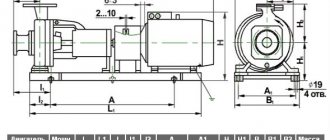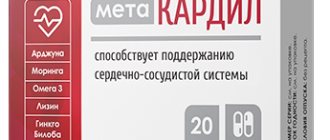An excess amount of cerebrospinal fluid in the skull compresses the brain, as a result of which a person experiences severe headaches, tissue swelling, weakness, fatigue and dizziness. To relieve this condition, there are pills for intracranial pressure.
They are indicated for patients who have been diagnosed with this by a neurologist. Comprehensive treatment based on medications, physiotherapy, massage, and other procedures will help you get rid of significant discomfort. Today we will talk about tablet medications designed to relieve symptoms of ICP (intracranial pressure).
When should you take pills?
To protect the brain from injury and shock, it is surrounded by cerebrospinal fluid (CSF), located in the area of the ventricles. Intracranial pressure is the accumulation of excessive amounts of cerebrospinal fluid in the skull, which creates additional pressure on the brain. This condition is fraught with the development of complications and requires immediate initiation of antihypertensive therapy.
Impaired circulation of cerebrospinal fluid leads to the development of the following symptoms, when they occur, you should begin taking medications to reduce intracranial pressure:
- severe headaches accompanied by nausea and gag reflex;
- blurred vision in the eyes, visual disturbances;
- fainting;
- manifestations of vegetative-vascular dystonia (dizziness, weakness, sweating, agitation);
- loss of performance;
- dark circles under the eyes.
At the same time, a person may experience pain in the stomach and heart. This condition cannot be ignored; you must consult your doctor to prescribe drugs that stabilize intracranial pressure.
How to identify the problem yourself?
It is impossible to determine the level of cerebral pressure at home, since this procedure requires special equipment. Normal values for an adult are 100-150 mm. rt. Art., if they increase, then the person experiences negative symptoms. You can independently identify intracranial hypertension using the following signs:
- regular headaches;
- nausea, vomiting not associated with food intake;
- causeless weakness, fatigue;
- memory loss;
- attention disorder;
- an attack of dizziness is accompanied by fainting;
- decreased peripheral visual acuity;
- sharp fluctuations in blood pressure;
- weak pulse.
The headache is long-lasting and constant, worsening at night and after waking up
The main manifestation of the pathology is intense headaches that are not amenable to medication. The pain syndrome is bursting in nature and is localized in the frontal, occipital, and temporal regions.
Diuretics
Drugs for intracranial pressure with a diuretic effect involve achieving a diuretic effect, due to which the volume of cerebrospinal fluid in the cranium will decrease, and the signs of increased ICP will subside. The rate of excretion of urine and liquid with salts increases due to inhibition in the renal tubules, due to which tissue swelling subsides.
Diuretics are divided into saluretics and osmotic agents. Osmotic drugs are designed to increase pressure in the renal tubules, as a result of which fluid will be excreted many times faster. Saluretics include loop diuretics (Furosemide) and carbonic anhydrase inhibitors (Diacarb, Acetazolamide).
Furosemide is the most common diuretic
Drugs that improve blood circulation in brain tissue
The main reason why intracranial pressure increases in adults is spasm of blood vessels as a result of their sudden compression and insufficient blood supply. To eliminate the symptoms of intracranial pressure, it is necessary to take drugs with the opposite effect - dilating the capillaries of the brain and accelerating the blood supply to brain cells.
Doctors recommend that patients take the following medications:
- Phenotropil;
- Nootropil;
- Encephabol;
- Sermion;
- Actovegin;
- Piracetam.
This list of tablets is not suitable for independent use at home; such drugs should be prescribed exclusively by a doctor, prescribing the frequency and dosage for each specific patient individually. Means that can be used independently with caution are Aspirin, Pantocalcin (Pantogam), Glycine and Gingko Biloba. In this case, you need to thoroughly study the instructions for use and not exceed the recommended dosages.
How to reduce intracranial pressure at home FAST
How to reduce intracranial pressure?
Diuretics will help you quickly reduce intracranial pressure at home: infusions of hawthorn, rose hips, meadow clover, lavender, etc. However, before using such methods, be sure to consult your doctor. Natural home remedies will help relieve ICP for a while, but will not cure the underlying disease that caused the pressure disorder. You can also improve your condition with self-massage of the head. To do this, you need to clasp your head with your fingers so that your thumbs are placed on the points on the back of your head. Using circular movements, you need to knead these points for several minutes a day. Stroking the neck muscles will help relieve pressure. To do this, you need to move your head back and, using a small round stick, stroke the back muscles of the neck from top to bottom. This massage should be performed for 10-15 minutes several times a day.
Medicines and tablets for ICP
Of course, one of the main therapies for treating ICP is medication.
IMPORTANT!
To treat intracranial pressure, tablets should only be prescribed by a doctor. Self-medication can lead to irreparable and sometimes fatal consequences.
As a rule, for the treatment of intracranial pressure, doctors prescribe diuretics such as Furosemide, Veroshpiron, antispasmodics Tempalgin, No-shpa, Spazmalgon. In extreme cases, if ICP has led to blurred vision and damage to the optic nerve, doctors may prescribe corticosteroid drugs - Prednisolone, Dexamethasone.
Folk remedies for reducing intracranial pressure
Traditional medicine will help eliminate headaches caused by intracranial pressure.
IMPORTANT!
Such methods are solely a way to temporarily alleviate the patient’s condition, or an additional measure to the main traditional drug treatment, and not as a full-fledged remedy for the treatment of ICP.
So, among the recipes of traditional medicine, the most effective are: - herbal infusions and decoctions. You can use the herbs valerian, sage, St. John's wort, horsetail, mint, lavender. 1 tbsp. l. dry herbs are poured with water, boiled for several minutes and the decoction is infused for at least half an hour. You need to drink this remedy a quarter glass three times a day for one month, then take a break; - alcohol tinctures. A very popular remedy for headaches is alcohol tincture of clover. Fill the jar halfway with dry clover flowers; add vodka or alcohol to the top. The medicine should be infused for two weeks in a dark, cool place. Then you need to strain the tincture and take the product twice a day, 1 tsp, after diluting it with a small amount of water; - garlic water. To get rid of pain from ICP, the following recipe will help: grind three lemons together with the skin through a meat grinder, add chopped three heads of garlic to the lemon mixture.
Mix all ingredients well, add 1.5 liters of regular boiled water and leave for 24 hours. Drink the medicine 1 tbsp. in the morning before breakfast for three weeks.
Beta blockers
Selective beta blockers are intended specifically for the treatment of intracranial pressure. Some of them, for example, Corinfar and Tenorica, have a prolonged effect, they need to be drunk only once every 24 hours, so this form is convenient for older people. List of effective drugs from this group:
- Nebivolol;
- Metoprolol;
- Atenolol;
- Betaxolol;
- Bisoprolol.
Drugs from the beta blocker group are identified by names ending with the syllable “lol”. They should be taken on the recommendation of a doctor, in the required dosage and with the prescribed frequency.
Basic reduction methods
The main goal in the treatment of cranial hypertension is to reduce pressure using conservative methods, the effect of which is to restore cerebral circulation through medication, lifestyle adjustments and special exercises.
To obtain an optimal and long-lasting effect, it is necessary to remove the causes that provoke the disease. Depending on the stage of the pathology and the patient’s condition, the specialist selects treatment tactics and therapeutic measures. Treatment can be carried out both in hospital and at home.
If the increase occurs against the background of brain tumors, then the pressure can be reduced exclusively by surgical methods, when there is a high risk of complications. For this purpose, the following neurosurgical types of lowering ICP are used:
Treatment of intracranial pressure in children
- Shunting (outflow of cerebrospinal fluid occurs through a catheter, which is inserted into the ventricles of the brain).
- Decompression craniotomy (removal of part of the cranial bone to relieve compression of the brain).
- Lumbar puncture (excretion of cerebrospinal fluid through a catheter that is inserted between the lumbar vertebrae).
- Ventricular puncture (outflow of cerebrospinal fluid through a puncture of the posterior or lateral horn of the ventricle).
Nootropics
Tablets for high intracranial pressure from the group of nootropic drugs help improve brain activity, normalize metabolic processes in tissues, and increase the ability of brain cells to remain without oxygen for a long time. Such medications help stimulate memory, concentration and attention, increase intelligence, ability to remember and process information.
Here is a list of effective nootropics used to reduce ICP and relieve signs of abnormal brain function:
- Cortexin;
- Cerebrolysin;
- Microhydrin;
- Piracetam;
- Actovegin.
Nootropics - drugs for the complex treatment of intracranial hypertension
Impaired blood supply to the brain occurs due to stress, infectious diseases, osteochondrosis (in particular, the cervical spine) and other negative factors. In addition to taking nootropic drugs, measures should be taken to eliminate these provoking factors, since an inadequate blood supply to the brain can not only disrupt vital processes in the body, but also increase the pressure of the cerebrospinal fluid inside the skull. Over time, the pathology can become chronic and cause serious consequences.
External methods of stabilizing ICP
In alternative medicine, there is a wide list of effective external methods that can provide first aid for intracranial hypertension:
- Bath with linden. It is necessary to take baths with linden decoction in a sitting position, so for preparation you need to take 4 cups of dried raw material per 10 liters of hot water.
- Rubbing the ears with cool water. The procedure is repeated many times until you feel better.
- Foot bath with mustard. Place 2 mustard plasters in hot water, lower your feet and soak for 15-20 minutes.
To stabilize the condition, craniosacral therapy is used, which consists of influencing certain points located in the temporal and occipital regions. Due to the gentle effect on the skull, ICP decreases and well-being improves.
High intracranial pressure is a dangerous condition, as it can lead to the development of emergency complications, including death. To stabilize it, there are a large number of medications and folk remedies that can eliminate the manifestations of pathology, but they do not affect the main etiological factor. Therefore, if signs of the disease occur, it is necessary to visit a specialist for diagnosis and further selection of the optimal treatment regimen.
Painkillers for headaches
What medications should I take to relieve the main symptom of increased intracranial pressure – headache? It can be diffuse, spreading over the entire area of the head, radiating to the temples and the back of the head. To reduce pain, take the following anesthetic drugs:
- Nimesil is a drug based on nimesulide, a substance with anti-inflammatory and antipyretic effects. The medicine effectively relieves pain for 10–12 hours in a row, and the effect begins 1–2 hours after administration;
- Ketoprofen - to soothe pain that occurs with increased intracranial pressure, you should take 1 tablet with a dosage of 50 mg up to 2-3 times a day;
- Ketorol is a tablet with a powerful analgesic effect that allows you to quickly and permanently get rid of discomfort.
Taking Askofen tablets based on caffeine, paracetamol and acetylsalicylic acid gives a good effect. But they slightly increase blood pressure, so it is recommended to drink them for people whose blood pressure levels are low or within normal limits. You need to understand that without appropriate therapy aimed at reducing the amount of cerebrospinal fluid in the meninges, it is impossible to achieve recovery with one dose of painkillers.
Can there be a noise in the head due to intracranial pressure?
Head noise and intracranial pressure are interrelated. With high ICP, the patient experiences discomfort from unpleasant buzzing, buzzing, hissing or ringing sounds. The intensity varies depending on the underlying disease.
Headache, noise in the head and ears are the main symptoms of high intracranial pressure. During the day, these symptoms may disappear on their own, reappear suddenly, or develop gradually, repeating over a long period of time.
Their feature:
- worsen in a horizontal position, so the clinical picture is most pronounced in the morning;
- bursting headache, pressing from the inside, not relieved by painkillers;
- pain spreads throughout the entire skull, most pronounced in the forehead, temples and back of the head.
Along with noise and pain in the head, the patient feels like something is pressing on the eyes, which causes vision to deteriorate and blurredness occurs. The pressure increases when the eyeballs move.
With ICP, cerebral vessels dilate, blood flow to the brain increases and its outflow decreases.
Other signs of the disease:
- nausea and vomiting (at the peak of the headache);
- dizziness;
- weather sensitivity;
- sleep disturbance;
- weakness, drowsiness;
- increased sweating;
- blood pressure surges;
- decreased performance;
- deterioration of memory, attention, intellectual abilities.
With high ICP levels, blood pressure increases, breathing is depressed and the pulse slows down, and the person loses consciousness. In severe cases, when vital structures of the brain are damaged, acute cerebrovascular accident occurs, convulsions, coma and death are likely.
Shpidonov Gennady Stanislavovich
Neurologist
Rostov State Medical University (neurology)
10 years of experience
Important! Impaired consciousness occurs when ICP increases to 30-40 mmHg. Art., coma – 40-50 mm Hg. Art., death – 50 mm Hg. Art. and higher.
We cannot wait for such serious complications. At the first signs of deterioration in health, you should consult a doctor.
Constant noise in the head is a common consequence of chronic cerebrovascular accident, against the background of which both arterial and intracranial hypertension can develop. Both conditions are life-threatening and can lead to stroke. Their diagnosis and treatment should be carried out by an experienced specialist.
Preparations containing amino acids
Preparations with amino acids help not only reduce intracranial pressure, but also accelerate the production of vital enzymes and reduce the load on the brain. These drugs include Glycine - it improves metabolic processes (metabolism in tissues), has an unexpressed sedative and hypnotic effect, and makes memory sharper.
When should you take Glycine:
- in stressful and conflict situations;
- with decreased concentration, attention and performance;
- during the recovery period after a head and brain injury;
- when under difficult conditions of physical and mental labor.
To improve brain function and get rid of regular headaches, the doctor can prescribe the drugs Cerebrolysin and Citrulline simultaneously with Glycine
Diagnostics
If there are signs of liquor-hypertensive syndrome, you should make an appointment with a neurologist. To make a diagnosis, the doctor prescribes a set of procedures:
- fundus examination;
- echoencephalography;
- X-ray of the skull;
- CT or MRI of the head
- Ultrasound of blood vessels supplying the brain;
- angiography.
In severe clinical cases, the doctor may prescribe a lumbar puncture, which helps determine accurate indicators of intracranial pressure.
The purpose of these procedures is primarily to identify the cause of hypertension. Based on the data obtained, the specialist determines a treatment regimen and prescribes additional diagnostics.
Other drugs
How else to reduce increased intracranial pressure, with the help of what drugs? The following medications are used for this:
- Diacarb. The drug is an analogue of Acetazolamide, also with diuretic properties. Diacarb has a hypotensive effect, a diuretic effect, reduces intracranial pressure, but this increases the risk of urinary excretion of magnesium, potassium, sodium and phosphates. Therefore, you need to take the tablets in combination with Panangin - it does not allow elements to be washed out of the body.
- Glycerol. The glycerol-based drug Glycerol has dehydrating properties. Once in the circulatory system, the active substance of the product helps remove most of the stagnant fluid. However, Glycerol molecules are similar to water molecules, so the drug does not cause dehydration and lowers intracranial pressure quickly and effectively.
- Treximed. The drug belongs to the group of drugs for migraine relief. It simultaneously relieves acute pain and lowers ICP, ridding the skull of excessive amounts of cerebrospinal fluid. The drug is not suitable for self-administration; it should be prescribed by a doctor in accordance with the clinical picture, age and weight of the patient.
Anti-anxiety drugs and antidepressants are also widely used in the treatment of intracranial hypertension. To calm the excited nervous system and reduce the signs of ICP, you can take tincture of Peony, Motherwort, Valerian or tablet preparations Novo-Passit, Persen, Magne B6.
Before starting treatment for the disease, it is necessary to undergo an examination by a neurologist and confirm the diagnosis of intracranial pressure. It is pointless to take medications on your own, since many of them have a lot of side effects, and if the diagnosis is not specified, they can only cause harm. The combination of medications is also dangerous, so only a doctor should prescribe therapy.
Intracranial hypertension
Intracranial hypertension, or increased intracranial pressure, is a dangerous syndrome that can be fatal. A syndromic diagnosis is established by a neurologist using examination and additional research methods. Increased intracranial pressure requires immediate and adequate treatment.
Unfortunately, in our country, this diagnosis is often made without any reason by everyone who is in any way connected with the examination of the head: ophthalmologists, therapists, radiologists. Intracranial hypertension is diagnosed both in adults and children, right and left. In this case, treatment is prescribed (mainly vascular drugs), which, naturally, does not lead to a cure. Often at an appointment you can hear that the patient has been treated for intracranial hypertension unsuccessfully since childhood and has been taking courses of vascular medications all his life.
What is intracranial hypertension really?
The skull is a closed space in which the brain, blood vessels, as well as cerebrospinal fluid (cerebrospinal fluid) and other structures are located. All these organs create a certain pressure inside the skull, which can fluctuate normally. Due to the fact that the bones of the skull in an adult are normally motionlessly connected, any increase in volume in the cranial cavity leads to an increase in pressure inside it. For example, intracranial pressure increases slightly when straining, then returns to normal values.
Certain medical conditions can cause blood pressure to rise or fall significantly, causing damage to structures inside the skull. For example, intracranial pressure slowly and steadily increases as a brain tumor grows. Since the bones of the skull are motionless and the tumor continues to grow, the volume of the contents of the skull increases, the pressure inside increases, the brain and blood vessels are displaced or compressed. All this leads to irreversible consequences and even death.
Intracranial pressure can rise very quickly with a cerebral hemorrhage or severe meningitis. In this case, emergency measures are required. A sudden decrease in intracranial pressure is also dangerous, as it can cause the brain to wedge into the bony openings of the skull and cause rapid death.
There is another type of hypertension - benign intracranial hypertension. The peculiarity is that the cause of the increase in pressure cannot be found; the disease may go away on its own. However, benign intracranial hypertension is a fairly rare disease. It is known that women are more likely to suffer from it, especially during pregnancy or if they are overweight.
What symptoms may bother you?
If the pressure changes smoothly, the patient may have various complaints. Among them, the most common are headache and vomiting in the morning or after being in a horizontal position. Sometimes blurred vision and double vision occur. Infants may have a bulging or retracted fontanel. The remaining symptoms are nonspecific: weakness, irritability, in children - a sharp cry, etc.
If the pressure inside has changed sharply, then most likely the person will be unconscious in a serious condition.
Research methods
First of all, I would like to say that intracranial pressure can only be measured by opening the skull. To date, there are no other methods for accurately measuring intracranial pressure. A stable change in pressure (mostly an increase) can be assumed using the following methods:
- Examination by a doctor to assess the movements of the eyeballs
- the patient may have strabismus due to compression of the abducens nerve, double vision while checking the range of movements of the eyeballs. In children, head circumference may increase. Pathological neurological symptoms, associated, for example, with a tumor, may be observed. - Fundus examination
- there may be blurred optic disc, vascular congestion and other nonspecific signs. - X-ray of the skull
- so-called “finger impressions” and other nonspecific signs may be visible. - MRI and CT of the head
- “empty sella” syndrome, dilatation of the ventricles of the brain and other nonspecific signs. - Ultrasound of the vessels of the head and neck
- there may be a violation of the venous outflow from the cranial cavity.
All these data must be assessed in combination, because each of them separately does not allow establishing the syndrome of intracranial hypertension. To make a diagnosis, you must also visit at least a neurologist and an ophthalmologist.
Unfortunately, there are often cases when, based on an examination by one specialist or based on the results of a single study, intracranial hypertension syndrome is established and treatment is prescribed. In most cases, headaches and visual disturbances are caused by completely different reasons (tension headaches, migraines, cervicocranialgia, etc.).
Treatment of intracranial hypertension
Treatment of intracranial hypertension depends on the cause of the syndrome.
And remember that real intracranial hypertension cannot be treated with vascular, nootropic drugs, physiotherapy and massage! This is a serious condition. This often requires hospitalization in the intensive care unit and emergency assistance from a neurosurgeon.
Be healthy!
Maria Meshcherina
Photo istockphoto.com











